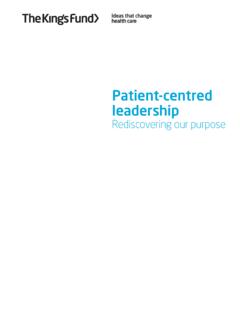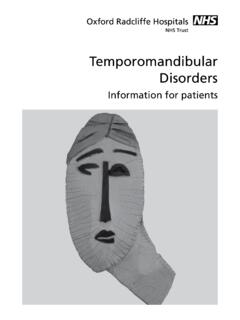Transcription of Adult Eating Disorders: Community, Inpatient ... - NHS …
1 Adult Eating disorders : community , Inpatient and intensive Day Patient Care guidance for commissioners and providers Adult Eating disorders : community , Inpatient and intensive day patient care guidance for commissioners and providers Publishing approval number: 000957 Version number: 1 First published: August 2019 Prepared by: NHS England with NICE and the National Collaborating Centre for Mental Health Promoting equality and addressing health inequalities are at the heart of NHS England s values. Throughout the development of the policies and processes cited in this document, we have: Given due regard to the need to eliminate discrimination, harassment and victimisation, to advance equality of opportunity, and to foster good relations between people who share a relevant protected characteristic (as cited under the Equality Act 2010) and those who do not share it; and Given regard to the need to reduce inequalities between patients in access to, and outcomes from healthcare services and to ensure services are provided in an integrated way where this might reduce health inequalities This guidance can be made available in alternative formats, such as easy read or large print, and may be available in alternative languages, upon request.
2 Please contact by emailing Contents Adult Eating disorders : community , Inpatient and intensive day patient care .. 2 guidance for commissioners and providers .. 2 Key Statements .. 4 1. 6 6 Purpose and scope of this guidance .. 6 Co-production .. 7 2. Optimal model of service 7 Key functions of care .. 7 Delivery of care .. 8 Assessing the needs of the local population and developing an Adult Eating disorder service .. 9 Comprehensive Eating disorder service .. 11 Joint working across services .. 12 3. Delivery of evidence-based treatment, care and support .. 12 Person-centred care .. 12 Accessing treatment, care and support .. 12 Assessment and engagement .. 13 Care plans .. 14 Support for families, partners, carers, friends and support networks .. 15 Medical monitoring .. 15 intensive community treatment .. 16 Inpatient and intensive day patient treatment.
3 16 Managing transitions .. 17 Managing comorbid conditions .. 18 Routine measurement of progress and outcomes .. 18 Advancing mental health equality .. 18 4. Definitions of terms and abbreviations .. 20 5. How was this guide developed? .. 21 6. References .. 26 Key Statements These statements were developed by people with experience of receiving treatment for an Eating disorder, as well as their family members and carers. They reflect what people want and need from Eating disorder services. People with experience of an Eating disorder I will receive collaborative, person-centered treatment that is focused on my needs and not just my weight or BMI (body mass index), to help me recover mentally as well as physically. I want professionals to show compassion, understanding and trust, while not making assumptions based on my diagnosis. Professionals who are working with me will understand how Eating disorders can affect people differently, and how they might get in the way of people accepting help.
4 I want people involved in my care to communicate with me and be open and transparent, explaining why certain decisions are made. I want to be able to voice my opinion and to be fully informed throughout my treatment. I want everybody involved in my care to communicate with each other. If I need Inpatient treatment, then I want my Inpatient and community team to work with each other. I want to stay connected to the real world so I don t feel like I have to start afresh after being discharged. I need the right support to help me transition back to the community . My treatment will always be based on the possibility of recovery and on helping me re- establish who I am, regardless of my past or the length of my illness. People won t give up on me. I will be involved in creating my care plan, which will include information about any transitions I have to make (geographical, age-based or Inpatient to community ), what to do if I am in crisis, how I can stay well and what to do if I experience a relapse.
5 I have the right to nominate a person to support me and my wishes will be respected around who I would like to be involved in my care or not. I want my community team to be trained and competent to offer evidence-based treatment, as well as a range of other support activities and groups. I would like my community team to be made up of a range of professions and I would like to meet all the individuals involved in my care. I should know who my care coordinator is and who to contact if I find myself in distress. I will be supported to make positive choices, but I will also be supported when I struggle to make these decisions for myself or I experience any setbacks. I would like the Inpatient unit to offer a structured treatment plan with regular groups and activities I can choose to attend no matter what weight I am, alongside individual therapy.
6 If I experience a relapse, I will be able to self-refer to the nearest Eating disorder service and I will be seen as quickly as possible. I will not have to go back on to a waiting list or feel like I have to become worse to be seen. Families and carers As families, carers, partners, friends or support people, we will be able to access and receive support to help our loved ones with an Eating disorder, regardless of whether they are getting treatment or not. Services will understand that carers who are partners and carers who are parents may have different needs and will give them the right level of information and support. Services will understand the distress we can experience and will help us to get support for our own mental and physical health. 6 1. Introduction Background Following a significant expansion of services for children and young people with Eating disorders , over recent years, there is now increasing commitment across a range of stakeholders to improve both timely access to, and the quality of evidence-based treatment in, Eating disorder services for adults and older adults .
7 The Parliamentary and Health Service Ombudsman (PHSO) recently published, Ignoring the Alarms: How NHS Eating Disorder Services are Failing patients . This establishes a clear rationale for localities to focus on improving care for adults with Eating As part of the NHS Long Term Plan, local areas will be supported to redesign and reorganise community mental health services to move towards a new place-based, multidisciplinary service across health and social care aligned with primary care networks. By 23/24 there will be new and integrated models of primary and community mental health care to support at least 370,000 adults and older adults per year including those living with Eating disorders , to give them greater choice and control over their care and support them to live well in their communities. Alongside this work, the New Care Models programme will give NHS led provider collaboratives the opportunity to redesign the pathway for adults with Eating disorders to bring care closer to home by giving them the responsibility for managing the budget associated with specialist care for this group.
8 Therefore, through a rebalancing of provision, from a focus on Inpatient services to expansion of community based services, adults with Eating disorders will be able to access treatment earlier, and closer to home, leading to better outcomes for them and their Purpose and scope of this guidance This guidance is primarily for commissioners and providers of Adult Eating disorder services (age 18 years and above), as well as people who use services and those who support them. It focuses on the optimum model of delivery (see Section 2), including information about the required skill mix in dedicated community Eating disorder teams to improve access to treatment, care and support. It covers care provided in the community , as well as Inpatient or intensive day patient treatment where required. The guidance covers services for a range of Eating disorders ; anorexia nervosa, bulimia nervosa, binge Eating disorder and other specified feeding and Eating disorders (OSFED).
9 This guidance should be read alongside a number of other guides, including: Access and Waiting Time Standard for Children and Young People with an Eating Disorder: Commissioning Guide,4 particularly in relation to managing transitions between services Eating disorders : Recognition and Treatment NICE Guideline (NG69) 2 Eating disorders Quality Standard (QS175)4 MARSIPAN: Management of Really Sick patients with Anorexia Nervosa5 7 guidance for commissioners of Eating Disorder services from the Joint Commissioning Panel for Mental Health6 Addendum to the Children and Young People s Commissioning Guide to include Inpatient and intensive Day Care episodes of care A Framework for community Mental Health Support, Care and Treatment for adults and Older adults (forthcoming). Co-production Co-production is key to developing and improving Eating disorder services.
10 To genuinely co-produce services, commissioners should develop and implement local plans in collaboration with: people with experience, service providers and partner agencies. More information can be found here. 2. Optimal model of service delivery Clinical consensus indicates that the optimal model of service delivery for people with an Eating disorder is a dedicated, multidisciplinary Eating disorder service. Care should be delivered in the community , supported by intensive day patient or Inpatient treatment for people with a high level of physical or psychiatric risk that cannot be managed safely in the community (see Section ). Adult Eating disorder services should provide a seamless pathway for young adults supporting a positive experience of transitioning from children and young people (CYP)-CED services where needed and avoiding unhelpful cliff edges in care.














